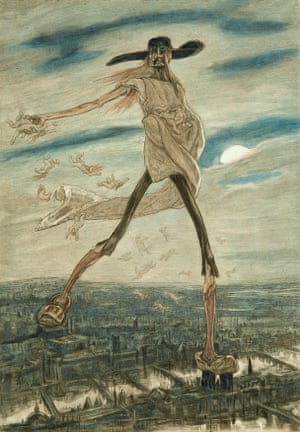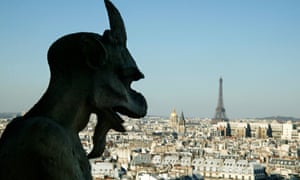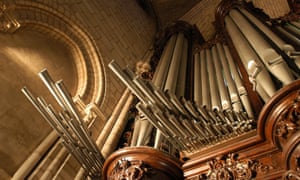Notre Dame and the culture it inspired – from Matisse to the Muppets
It mesmerised Proust, terrified Homer Simpson and gave us the Hunchback – Guardian critics celebrate Paris’s gothic masterpiece at the heart of the modern imagination
Oliver Wainwright, Stuart Jeffries, Peter Bradshaw, Jonathan Jones, Fiona Maddocks, Michael Coveney and Keza MacDonaldTue 16 Apr 2019 16.13 BST
Architecture: ‘Pugin fainted when he saw its beauty’
As Notre Dame Cathedral’s majestic spire tumbled into the inferno on Monday night, live newsreaders around the world decried the tragic loss of this 12th-century marvel. The great timber roof – nicknamed “the forest” for the thousands of trees used in its beams – was gone, the rose windows feared melted, the heart of Paris destroyed forever. What few realised in the heat of the shocking footage was that much of what was ablaze was a 19th-century fantasy. Like most buildings of this age, Notre Dame is the sum of centuries of restorations and reinventions, a muddled patchwork of myth and speculation.
Standing as a sturdy hulk on the banks of the Seine, the great stone pile has never been the most elegant or commanding of the ancient cathedrals, but it became the most famous. Begun in 1163, it was larger than any gothic church before it, employing some of the first flying buttresses to allow taller, thinner walls and larger expanses of glazing – including the spectacular rose windows that projected great cosmic wheels of colour into the luminous interior. “Where would [one] find … such magnificence and perfection, so high, so large, so strong, clothed round about with such a multiple variety of ornaments?” asked John of Jandun, in his 1323 Treatise on the Praises of Paris. Five hundred years later, the gothic revivalist architect Augustus Puginfainted when he first encountered Notre Dame, so overwhelmed was he by its beauty.
The only solace one might take from the horrific fire is that it is merely the latest chapter in a long and violent history of destruction and repair. The cathedral was heavily damaged by rioting Huguenots in the 16th century, remodelled by successive kings and roundly plundered during the French Revolution, when the 28 statues of biblical figures on the west façade, mistaken for French kings, were ritually beheaded.
It was Victor Hugo’s 1831 novel Notre-Dame de Paris (translated as The Hunchback of Notre Dame) that brought the cathedral’s plight to widespread attention, raising alarm about the “mutilations, amputations [and] dislocations” of the structure, and making gothic architecture touch the popular imagination in a way it never had before. His writing spurred on calls for a full restoration, eventually undertaken by Eugène Viollet-le-Duc, who was just 30 when he won the commission with Jean-Baptiste-Antoine Lassus in 1845. Over the next 25 years, he would mould Notre Dame according to his own romantic vision, adding elaborate layers of ornament and decorative statues of entirely his own invention.
His enormous spire, made of 500 tons of wood and 250 tons of lead, was a far cry from the previous tower (removed in 1786 due to instability), modelled instead on a 19th-century spire in Orléans. Around this great flèche, he concocted a fantastical menagerie of apostles and mythical creatures – most of which appear to have been saved from the flames, having already been removed for restoration.
History hasn’t been kind to Viollet-le-Duc’s work. Victorian architect William Burges called him a “disastrous restorationist”, while Charles Hiatt’s 1902 account of the cathedral’s redecorated interior bemoaned that “the colour confuses our appreciation of the fine lines of the architecture, and it is frequently restless and irritating where it should be most reposeful”. Critic Ian Nairn passed a damning judgment on Notre Dame in the 1960s, calling it “one of the most pessimistic buildings in the world [with] no hope of change, and no glimmer of ultimate purpose,” adding that “Viollet-le-Duc’s musty and self-righteous cackle can be heard all over the building”.Yet the echoes of this gleeful, overripe cackle are exactly what made Notre Dame so seductive to the imagination of the millions of tourists who flocked here each year – and who will no doubt continue to do so when it is rebuilt, with yet another layer of creative interpretation added to the rich historical collage. Oliver Wainwright
Literature: ‘Proust gazed at it for two hours’
In 1904, Marcel Proust wrote an article for Le Figaro whose title, The Death of Cathedrals, now takes on painful resonance. Proust, who so loved gothic ecclesiastical architecture he would inveigle his beloved chauffeur-lover Alfredo Agostinelli to light up church facades with headlamps so he could study their stones, one evening threw a fur-lined coat over his nightdress so he could spend two hours gazing at Notre Dame’s portal of Saint Anne.
The death Proust was lamenting was not so much sacrifice to flames as the insufferable consequence he inferred from a contemporary governmental plan that allowed cathedrals like Notre Dame to be converted into “museum, concert hall, or casino.” As his biographer Jean-Yves Tadié points out, though agnostic and Jewish, Proust was so fired by the passion inculcated in him for gothic architecture by John Ruskin that he couldn’t bear the thought of Catholic churches being thus repurposed. His great novel, À la Recherche du Temps Perdu, revels in lapidary descriptions of churches, great and small.
Sigmund Freud, another secular Jew and contemporary of Proust’s, was similarly entranced by Notre Dame. The first time he saw it, in 1885, Freud said he had “a sensation I never had before.” Thereafter, between studying with neurologist Jean-Martin Charcot at Salpêtrière Hospital, he returned to Notre Dame “every free afternoon” to be in its presence. “I have never seen anything so movingly serious and sombre,” Freud said.
But Notre Dame has an even more sombre incarnation, one that reeks of death and damnation. In 1866, Baudelaire published Les Épaves (Scraps), a collection of incidental verse including six censored poems from the 1857 edition of Les Fleurs du mal, one of whose poems, Le Joueur généreux, includes the line: “The finest trick of the devil is to persuade you that he does not exist.” Its frontispiece includes a hideous skeleton, described by British Library curator Chris Michaelides as “symbolising the tree of good and evil, in whose feet grow flowers representing the seven deadly sins. Angels and cherubs are flying high above around a medallion of the poet carried away by a chimera.”
The artist of that frontispiece, Félicien Rops, perhaps inspired by Baudelaire, made that devil’s existence sickeningly plain in his 1882 image Satan semant l’ivraie(‘Satan sowing seeds among the wheat’). In it, Michaelides relates, a gigantic Satan is crossing Paris, casting seeds of discord from his right hand. The seeds, misogynistically enough, are women. Worse, his right foot rests on – perhaps even crushes – the twin towers of Notre Dame.
But it is Hugo’s Hunchback through which literature bends the knee most eloquently to the cathedral. Hugo wrote it in part to catalyse interest in the gothic building, which had fallen out of fashion in Paris. At one point in the vast novel, the villain, Judge Claude Frollo, directs his visitors to look away from a book on his desk to the massive silhouette of Notre Dame Cathedral. “This will kill that,” he remarks. The idea is that the printing press will destroy the cathedral, that the renaissance will murder religion, silence the eloquence of churches. “Small things overcome great ones,” Frollo says, “the book will kill the building.” For Hugo, Stonehenge, the Parthenon and indeed Notre Dame are “books of stone” pregnant with meaning.
Not that all Notre Dame is as venerable as we might suppose. Eric Hazan, the city’s great historian, wrote in his recent book A Walk Through Paris a passage that seems to have been composed for tourists arriving on the Eurostar. “It is a shame that no one stops to contemplate [the facade of the Gare du Nord],” he writes, “whereas crowds throng in front of the facade of Notre Dame, whose statuary is no older than that of the railway station.” The station’s facade is, Hazan argues, a masterpiece. While the world awaits the rebuilding of Notre Dame then, there are consolations. Stuart Jeffries
Film: ‘Gene Kelly danced in its shadow’
There are numberless postwar movies set in Paris that use Notre Dame as an establishing shot, embedded as part of the city’s legendary fabric and its furniture, the camera sometimes noticing it just subliminally. Paris is habitually a signifier for the secular world of romance and adventure, so using the cathedral more explicitly is not an obvious choice. Jean-Paul Belmondo reads the paper with Notre Dame in the background in Godard’s Breathless; Leslie Caron and Gene Kelly dance in Notre Dame’s shadow in An American In Paris; Cary Grant and Audrey Hepburn walk past it as they talk about murder in Charade.
The most stunning – and now eerily prescient – “movie tourist” use of Notre Dame is Richard Linklater’s Before Sunset in which the reunited lovers Jesse and Céline ponder the cathedral and Céline says: “But you have to think that Notre Dame will be gone one day …”
But of course the most sensational use of Notre Dame is in The Hunchback Of Notre Dame in 1939, based on the Victor Hugo novel (there were two earlier silent versions and many remakes since, including a Disney animation). Charles Laughton is the poignantly lonely and lovelorn Quasimodo, the cathedral’s bellringer who rescues Esmeralda (Maureen O’Hara) from public hanging for witchcraft by swinging down Tarzan-like from one of his bell-ropes and bringing her back to the bell tower for sanctuary. That is: the North Tower, whose ancient oak frame has now been destroyed, and the fate of its four immense bells still uncertain.
The film breathtakingly reverses the usual movie grammar of Notre Dame; instead of incuriously glimpsing the cathedral on the skyline, we are around and inside it, getting a stunning reverse view of Paris from the tower – that is, the fake medieval Paris built in the San Fernando Valley – as the agonised Quasimodo looks out over the teeming city with all its drama and compares himself to the gargoyles he stands next to. The movie was instantly felt to be a symbol of anti-Nazi defiance.
Later, Paul WS Anderson’s version of Three Musketeers staged a swordfight on the cathedral’s roof, and Jean-Pierre Jeunet’s whimsical romance Amélie had the heroine’s mother bizarrely killed by a suicide jumping from Notre Dame. During their ominous conversation about Notre Dame in Before Sunset, Jesse and Céline talk about Nazi plans to destroy the city before the Allied advance. In René Clément’s Is Paris Burning?, Orson Welles plays the Swedish consul who dissuades the Nazi governor from anything of the sort — because Notre Dame has to be saved. Peter Bradshaw
TV: ‘Its function has been to scare the crap out of you’
In The Muppet Show in 1981, the show’s opening number featured a blue headed, green haired chap called Mulch performing the role of Quasimodo. He climbed to the bell tower of Notre Dame to sing a love song. “The bells are ringing,” he began gamely, “for me and gargoyle / The birds are singing for me and gargoyle.”
And then, in unexpected application of the Pygmalion myth, the love of his life, though no looker, unpeeled herself from the parapet and mutated from stone into a singing puppet. “Everybody’s been knowing to a wedding they’re going,” she sang. “And for weeks they’ve been stowing days of labour and toil.” And then some other hideous troll-like figures, sculpted into the parapet below, came to life and sang the chorus.
Though the episode’s special guest was Debbie Harry, her performance of Blondie’s One Way or Another was no match for this reworking of the 1917 standard For Me and My Gal, best known from its outing in the Gene Kelly 1942 film of the same name. Its gag worked through the same hilarious principle of the Rodgers and Hart song Manhattan, with its couplet: “The city’s clamour can never spoil / The dreams of a boy and goil.” Though why French gargoyles sing in New York accents is beyond me.
Television’s relationship with the Parisian landmark has switched vertiginously from comedy to gothic horror. The 2016 Simpsons episode To Courier With Love has the family flying to Paris because Homer has to work as a courier transporting an endangered Amazon blue constrictor snake into the country for reasons too bizarre to get into. One night in Paris, while Bart is fishing in the Seine, and Lisa, you’d suspect, debating philosophy at Les Deux Magots, Homer dons the proverbial existentialist turtleneck and with Marge strolls past the cathedral. Admiring the gargoyles, Homer remarks: “That’s from back when religion knew how to scare the crap out of you”, clearly not knowing that the Muppets had taught us those stones could come to life and sing of love like native New Yorkers.
And yet, Homer had a point. Notre Dame’s function on television has often been to scare the crap out of its audience or, what is the same thing, provide backdrop for gothic hokum. In Jo, the English language, Paris-set police procedural seriesstarring Jean Reno as the eponymous Joachim Saint-Clair, for instance, one episode starts with a body found beaten and strangled under the Last Judgment portal of Notre Dame. The victim’s ears have been pierced and his face tilted so that his dead eyes are aimed at a figure of an angel blowing his trumpet to wake the dead for the final judgment. Jo’s theory is that the killer has made the the victim symbolically deaf to the angels’ trumpet, suggesting the victim wasn’t worth God’s mercy.
But the future for Notre Dame on television is uncertain. Last year, actor Tom Hollander’s production company enlisted screenwriter Andrew Davies to develop an adaptation of Victor Hugo’s 1831 novel. Hollander himself told Radio Times he wanted to play Quasimodo, though he’d equally be good as Esmeralda. I’ve a hunch (so very sorry) that this adaptation, if it goes ahead, will take on a very different resonance now.
Stuart Jeffries
Art: ‘A synthesis of medieval faith and modern fantasy’
To understand the artistic wonder that is Notre Dame you have to accept it as a synthesis of medieval faith and modern fantasy. Viollet-le-Duc crowded the real Notre Dame with grinning, devilish gargoyles just as Hugo populated his fictional one with a deaf bell ringer and his tormentors. This intermixing of a genuine gothic cathedral with the 19th-century dream of what gothic should be has put Notre Dame at the heart of the modern imagination. It’s the artistic embodiment of Paris, the centre of medieval European thought and culture which in the 1800s became the birthplace of modern art.
For at least 300 years before Viollet-le-Duc saved Notre Dame, medieval cathedrals had been shunned. When London’s gothic cathedral St Paul’s was destroyed in the Great Fire of London it was replaced with a trendy new domed edifice by Christopher Wren. No-one this morning is calling for a new Notre Dame to be built by France’s contemporary architectural star Jean Nouvel. That’s because Viollet-le-Duc, who also restored churches across France and the lovely walled city Carcassonne, taught us what makes medieval architecture so magical.
It is the human plenitude, the sense of hundreds of anonymous masons working in humble collectivism, and thousands of people across time sharing our awe for what they built, that gives Notre Dame its mystique. A great cathedral is a vast living organism. It’s like being inside a whale, the vaulting a sublime rib cage above you. Unlike a symmetrical classical building a gothic cathedral is not an image of order but living disorder where flying buttresses sprout, mighty columns soar, lofty galleries conceal prayers and plotters.
Viollet-le-Duc loved the monsters at the edge of medieval Christianity, basing the gargoyles and chimeras that cover his restored stonework on works in French museums. His macabre Notre Dame is the birthplace of French modern culture from Baudelaire’s poetry and Rodin’s Gates of Hell to Matisse’s painting of its unmistakable facade in pink morning light. Yet under all its accretions, the heart of Notre Dame is truly medieval. Gothic architecture was born in Paris. Abbot Suger of Saint-Denis, on the French capital’s outskirts, invented this art style in the early 1100s to glorify God in a spectacular new way. To let in sacred light, gothic builders created stained glass windows – and to make space for those, they raised buildings higher than ever before. Flying buttresses and the pointed arch redistributed the structure’s weight so cunningly that huge areas of wall could be replaced with glass. If Notre Dame survives it will be because the flying buttresses did their job.
It was hard to resist the sense of miracle when a photograph of the interior showed Notre Dame’s cross shining through smoke. Another image shows holes in the stone vaulting – but the interior is still the sculpted space the medieval masons made. As it seemed Notre Dame was perishing last night, I was heartbroken. But unless there’s fatal structural damage yet to be revealed, it seems the stones of Paris are holding up. And everything else can be replaced. A cathedral can endure the loss of its stained glass and other fineries, as has happened in Britain where all our cathedrals were vandalised in the Reformation and civil war.
It’s precisely this endurance that makes medieval architecture so special. Almost a thousand years after its original creation Notre Dame still speaks to us. Like cave paintings, it connects us with some primal aesthetic urge. Now our time faces a challenge. Do we still have in us the love, idealism and skill that enabled Viollet-le-Duc and his workers to recreate a gothic masterpiece? If we can reawaken the creativity this building embodies it will be a great moment of artistic renewal for today’s Europe. Jonathan Jones
Music: ‘Vierne died at the famous organ’
Music has been part of Notre Dame’s history since its foundation. Some of the earliest known European composers, working in Paris around 1160 to 1250, wrote music for the liturgy each week even as the great cathedral was being built around them. Collectively these composers are known as the Notre Dame School. Their names are mostly forgotten. Through a 13th-century English scholar, known as Anonymous IV, we know of the two most important: Léonin and Pérotin.
Their lasting significance was to write down and develop western musical techniques which had previously only been extemporised. Their polyphonic motets (written for more than once voice) replaced the single line of Gregorian chant, common up to that point. The Magnus Liber Organi (“great organum book”), a collection of Notre Dame works, is one of the greatest single achievements in medieval art, a cornerstone of European music for the next three centuries. Léonin, according to Anonymous IV, made the collection, Pérotin later revised it. The American minimalist Steve Reich paid tribute to Pérotin in his vocal and electronics work Proverb.
Another globally important strand of musical life for Notre Dame is the historic organ, central to the flowering of French organ music. The current instrument, spectacular in size and symphonic sound, was originally built by the leading French organ maker Aristide Cavaillé-Coll in 1868. It has survived two world wars and was substantially improved in 1963 and again in 1990. Played on five keyboards and pedals, it has nearly 8,000 stops and an advanced computer system.
Several French composers have held the position of organist at Notre Dame including Louis Vierne who collapsed and died at the organ console after a recital to 3,000 people. The most idiosyncratic, quirky and brilliant in modern times was Pierre Cochereau, improviser, composer, pedagogue and one of the greatest organists of the 20th century.
Fiona Maddocks
Stage: ‘Provided a hit for Celine Dion’
All great cathedrals are spectacular and dramatic, but the specific theatricality of Notre Dame is bound up in the mythology of Victor Hugo’s great novel. Hugo himself was thinking of the opera house soon after publication in 1831 and duly cooperated with composer Louise Bertin on a grand opera in four acts, La Esmeralda.
This flopped, but five more romantic operas soon followed. Apart from the films and television series, there have been countless theatre versions, too, in recent years ranging from Ken Hill’s sparky adaptation for the National Theatre in 1977, through Strathcona Theatre Company’s small-scale touring edition in 2001. One forgotten musical was based on the Disney film, and several ballets have included Roland Petit’s for the Paris Opera Ballet in 1965.
But the main theatrical stab at the story in recent years was the 1998 Notre Dame de Paris, a French Europop concert that provided a hit soundtrack for Céline Dion after it was premiered at the Palais des Congres, a building conceived in an alternative plane to the cathedral’s scale and sublimity.
Our Francophile producer, the late Michael White, presented the show at the Dominion in London in 2000, with Tina Arena and blocks of concrete misrepresenting the cathedral. And it’s this powerfully ingratiating score – by Richard Cocciante – with gloriously banal book and lyrics by Luc Plamondon, that ripped up the Coliseum only a few weeks ago with an acrobatic chorus of Parisian low-life decked out in primary colour satin trews and boleros.
Most critics in 2000 panned the show, no doubt hoping to be right after being, mostly, wrong when Les Misérables (1980 in Paris) opened here in 1985. It was, they said “a load of old bells”, “all bats and no belfry”. Sheridan Morley decried Quasimodo’s disabled backing group who scuttled up and down the cathedral bell tower “in a futile attempt to escape the show”. Frankly, it gave him the hump.
Notre Dame itself really needs no dramatising. It has David’s paintings, stained glass, the magnificent organ and an impasto of ceremonies and coronations that should, God and the restoration willing, run for ever.
Michael Coveney
Video games: ‘You can shimmy up its majestic exterior’
In video games, architecture is more than set-dressing. When a player can move through a piece of art, examine it through touch, movement and interaction as well as visually, the composition of virtual spaces and buildings becomes as vital to the experience as code, sound and visual design. Game designers’ art, like architects’, is that of expressing something through a space.
A great many video game creatives show a weakness for the imposing beauty of gothic architecture in their work. Echoes of Notre Dame can be seen in games from eldritch horror Bloodborne to the arch-fantasy World of Warcraft. For Assassin’s Creed Unity, a historical game set during the French Revolution, an environmental artist named Caroline Miousse spent the best part of two years recreating Notre Dame Cathedral in a virtual 18th-century Paris, working from old maps of the city, sketches and photographs. Notre Dame didn’t have its spires at that time, but in the game they are there, a concession to the modern player’s mental image of the iconic building. You can climb right to the top of the cathedral and survey the city below; inside, you can see the paintings that were hanging on the walls 250 years ago. Experiencing the cathedral in-game having seen it in the flesh evokes a powerful, intimate sense of deja vu. You can’t touch its ancient stone in a game, of course – though in real life, you can’t shimmy up the majestic exterior like an 18th-century Spider-Man and view the Paris skyline from its peak.
Few would have foreseen it, but the work that Ubisoft Montréal did in building a virtual Notre Dame may now be of use in rebuilding the real one. It is a reminder that video games, in recreating architectural wonders, now play an important role in their cultural preservation.
Keza MacDonald









No comments:
Post a Comment